« Current Project- Arbor | Main | From the Drawing Board: Water Feature »
December 08, 2006
Common Landscape Mistakes: Fences
A continuing entry in our Common Landscape Mistakes series:
Fences are a fairly basic element in landscape construction, but one where we see common mistakes in design and construction. Here is a guide to fence types and ways to avoid common mistakes.
Proper construction of fencing really depends on the type of fence being installed.
The basic fence types are as follows:
1 -Perimeter Fence- metal, wood or wood and wire. Typically constructed for privacy on back or side yards. Heights typically 4-6’
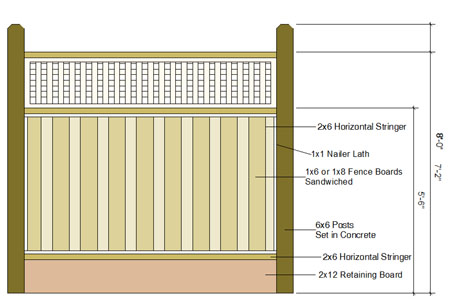
8' Fence with Lattice
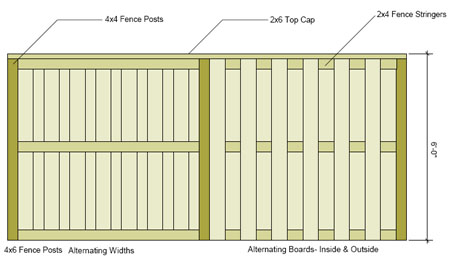
Examples of Standard 6' Fence and Alternating Board "Good Neighbor Fence"
2 -Front Fence- Typically a picket style, or semi-transparent design, heights typically to 3-4’
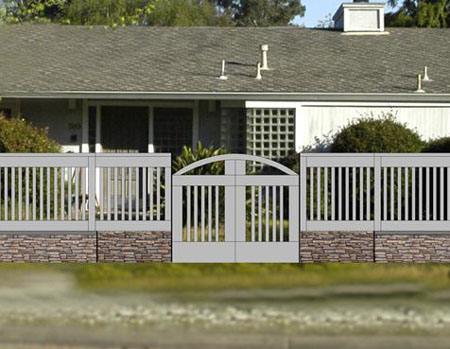
Mock-up of vertical picket fence on top of wall
3-Deer Fence- to restrict deer access, typically wood and wire, or wire and Metal T-post construction, heights typically 4-6’
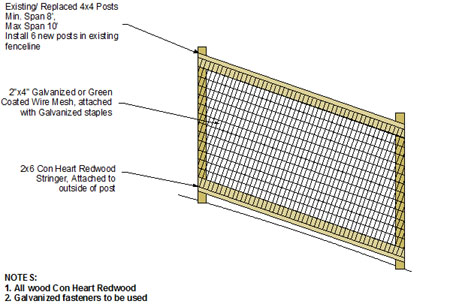
Wood and Wire Deer Fence on Sloped Terrain
4-Railing: Typically wood, tensioned cable, or prefabricated metal. Heights typically to 3’
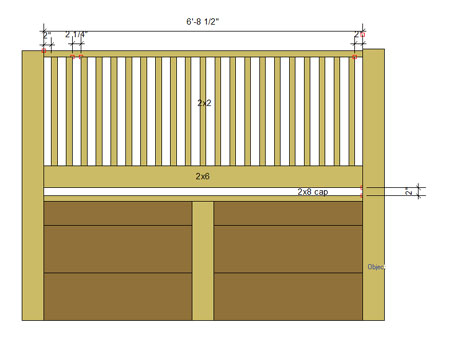
Wood Railing on Top of Retaining Wall
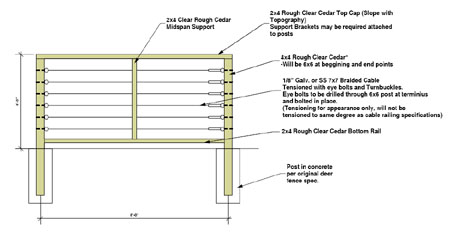
Cable Railing with Wood Frame
Construction: Fences are composed of a few key elements-
-Posts: typically set in concrete
-Stringers: Horizontal boards connecting posts
-Fill: Fence Boards, wire mesh, tensioned wire, etc.
-Decorative elements: Wood lattice, extended trellises, kicker boards, decorative detailing
Biggest Mistakes:
Here a few of the most common fence construction mistakes we see:
1-Horizontal Stringers: 2x4 boards are the most common stringers used in fencing. These boards typically span posts, spaced 8’ on center. Because wood at this span will have a tendency to sag, it is important that the strongest orientation of the board is used- in this case the 4” side, not the 2” side. Horizontally oriented 2x4 stringers spaced at 8’ spacing will show a noticeable bow over time.
-Insufficient stringers- we prefer 3 stringers for some styles of fence, especially over 6’. There are some fence designs where 2 stringers are insufficient.
2- Poor Posts:If the style will allow, pressure treated posts can be used to help resist weathering. In cases of finished fencing, a decay resistant wood such as redwood or cedar should be used. Untreated wood used outside will weather and decay rapidly. Post should be set in concrete, typically 9-12” in diameter and at a typical minimum of 18” in depth, with gravel installed at the base of the base pier to allow water to escape. Posts poorly set, will result in a structurally unstable fence, that will likely lean, or blow over in a storm.
3- Ugly Styling: Some fences are just downright ugly. Take a look in your neighborhood to find fences that have a good style of construction and a good aesthetic.
4- Poor fastening: screws or nails can be used for fastening the fence depending on application. Nails and screws should be galvanized at a minimum to prevent excessive rust and weathering; on high quality fencing stainless steel screws or nails should be used.
5-Too tall: Fences over 6’ need special construction considerations- 4x4 posts are typically not strong enough, 4x6 or 6x6 posts should be used. Sufficient stringers should be used on tall fences, 1” thick fence boards should not exceed a 5-6’ span vertically between stringers, if they do, they are likely to warp. Check also with your local building department, frequently fences over 6’ require permitting (sometimes 2’ of wood trellis is allowed, totaling 8’)
Posted by Michael O'Connell at December 8, 2006 08:33 PM
Comments
Post a comment
Thanks for signing in, . Now you can comment. (sign out)
(If you haven't left a comment here before, you may need to be approved by the site owner before your comment will appear. Until then, it won't appear on the entry. Thanks for waiting.)